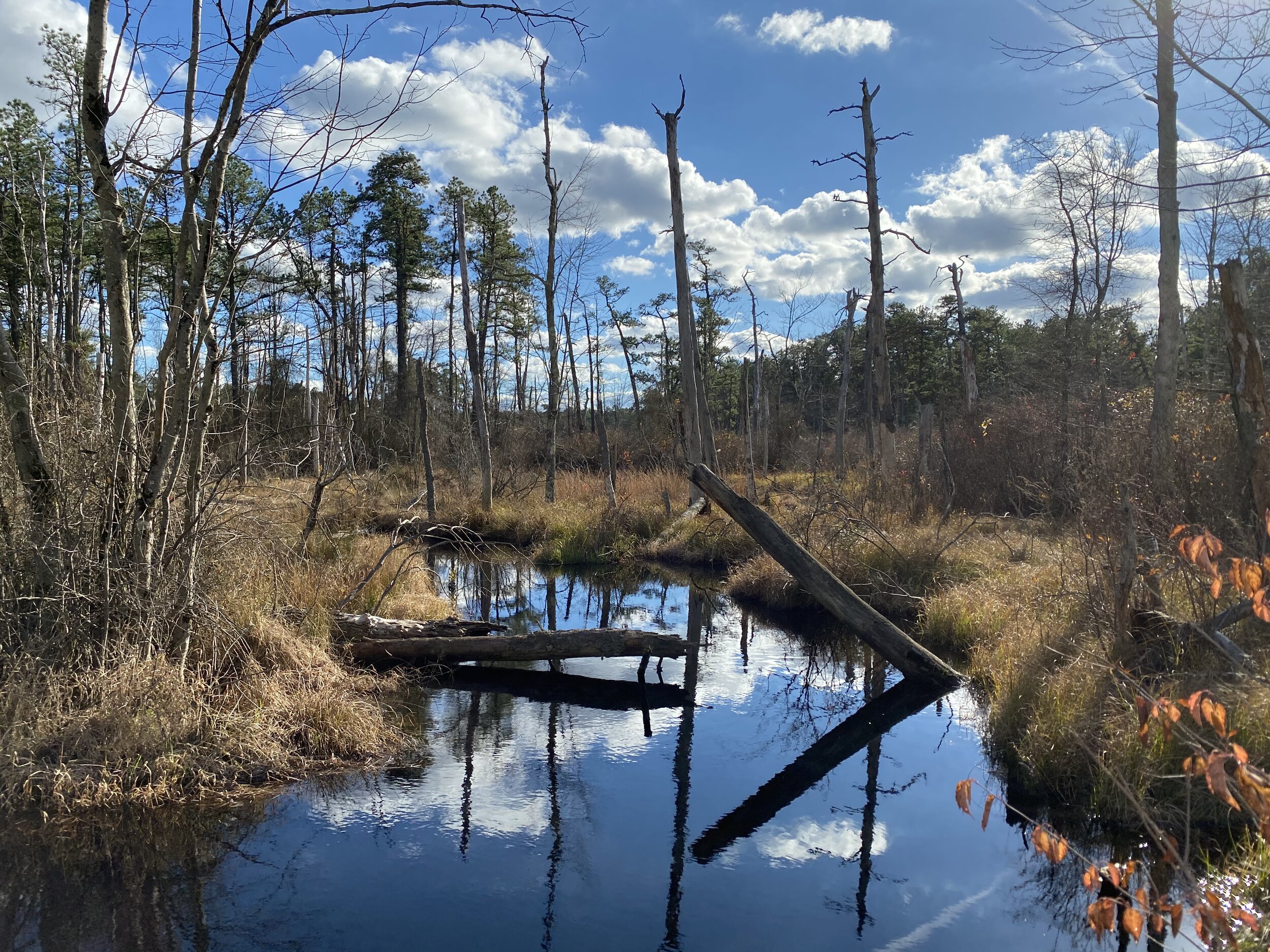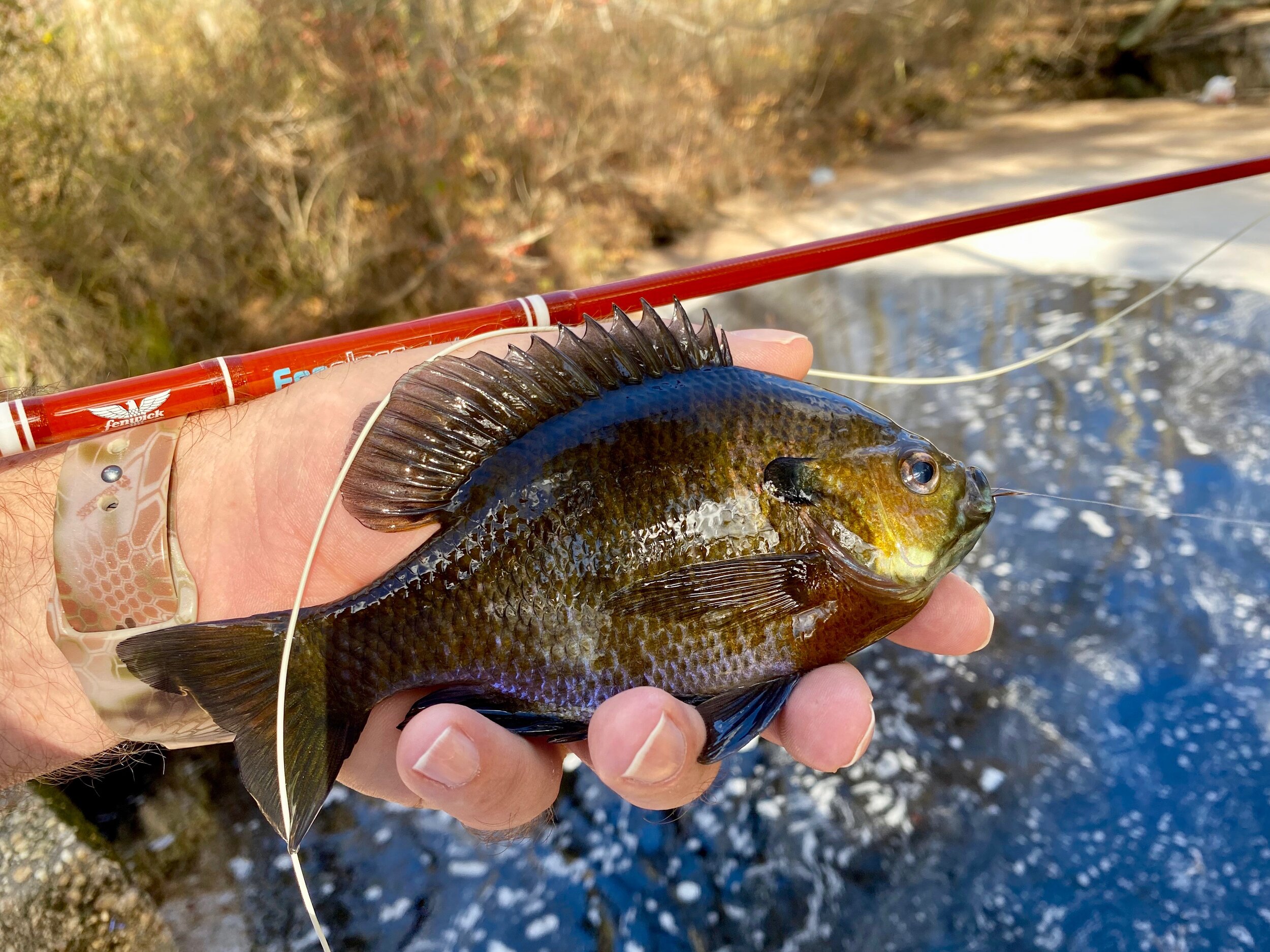The term Blue Lining usually refers to fishing small, often remote, trout streams for native or wild fish. I had a craving for a little blue lining myself but at the height of "leaf season" here in New Jersey, fishing our small wild trout streams that flow through hardwood forests is an exercise in futility, at least until the leaves are off the trees. That being the case, a different kind of blue lining was in order. I headed to where trees have needles instead of leaves, the Pine Barrens. New Jersey's Pine Barrens is an expansive wilderness area in one of this nation's most populous states; it contains 1.1 million acres of pine forests, wetlands, streams, rivers, lakes, and bogs. Although some trout can be found in the Toms River and its tributaries, I was more interested in the Barren's native species, particularly its native sunfish. The Pine Barrens are home to two species of sunfish seldom found outside of that area. They are the Black Banded Sunfish and the Mud Sunfish.
A typical Pine Barrens bluegill. They tend to take on the colors of the tannin stained water they live it.
On an unseasonably warm November day, I loaded up a daypack with lunch and the gear needed for a day in the wilds, grabbed a short, light fiberglass fly rod, and a blaze orange hat to ward off the errant hunter. I hopped in the truck and headed south toward the Pine Barrens' northern edge, which is a short ride from my home. In no time at all, I was bouncing down a sand road not found on either my vehicle's or phone's GPS with no particular destination in mind. As the road became less traveled, it also became smaller. Soon brush was continually rubbing up against the side of my truck. The last time I was back this deep in the barrens, I drove a nimble Toyota FJ Cruiser. This time around, I felt far less confident in my crew cab F-150 pick up truck. As the trees closed in, I became more than a little nervous about the fact that I may not be able to turn around if the road ran out of sand as they often do or became impassable due to a fallen tree or a stream re-routed by a beaver. I did not look forward to the prospect of backing up a pickup truck down a few miles of narrow winding fire roads.
Although no native sunfish species were caught on this trip, there were plenty of other sunfish found in the deeper holes of this particular creek.
As I started to look around for a place to turn around between the trees, I came across a small but deep looking stream. All the streams in the Pine Barrens look deep. Their tea-colored tannin-stained water and dark stream beds make it all but impossible to gauge their depth. I pulled the truck off the narrow sand track as far as I could, though I likely could have left it parked right in the middle of the narrow lane as my vehicle tracks were the only tracks on the ground, and I seriously doubted anybody would be coming by that afternoon. Slipping on a pair of knee-high boots and grabbing my rod and daypack, I followed the stream into the woods. At first, the stream seemed devoid of fish, but I hooked a scrappy little fish on my first cast when I arrived at my first sizeable pool. Unfortunately, it appeared to be just a generic bluegill, not one of the unique, native sunfish I was seeking. Both species of native Pine Barren sunfish prefer waterways with abundant vegetation. I don't know if it was the lateness of the season, or I if had inadvertently selected a stream devoid of plant life but there were no weeds visible any where in this stream. The dark tea-colored water made it very difficult to read. Perhaps this lack of vegetation prevented me from completing my mission of catching a New Jersey native sunfish. Plenty of fish were caught, but they were all ordinary run of the mill bluegills. Not that I am complaining! They put a deep bend in the fly rod and were considerably larger than the native fish I sought.
The Pine Barrens sits on top of a 17 trillion gallon aquifer of fresh water! This beaver pond is one of thousands of lakes and ponds that dot the landscape.
After following the stream's winding course for an hour or so, it flowed into a small beaver pond. Though the thick vegetation on the shoreline made it challenging to cast, I could carefully wade the firm sand bottom around most of the lake as long as I did not go more than calf-deep in the water. A pair of hip boots would have been ideal in this situation! This little pond was chock full of another NJ native, the chain pickerel. On almost every cast, I received slashing strikes from small foot-long pickerel that have probably never seen a fly! By cutting back my leader, I managed to keep most of my flies when hooking these smaller fish. However, every time I caught a larger pickerel, I was relieved of my fly in short order. At one point, I looked into my box and realized most of my flies were gone. Most lost to the razor sharp teeth of pickerel and a few to tree limbs behind me.
Small pickerel like this one are often landed without much difficulty. If they get much bigger, their mouth full of razor sharp teeth make quick work of light tippets. This little fellow’s big brothers and sisters cost me a lot of flies because I failed to bring a bite tippet along on this trip!
Though it was only about a quarter to four, the sun was sitting surprisingly low in the sky. It was time to reel in and begin the walk back to the truck. Many people become lost in this neck of the woods because the forests are very disorienting. Everything looks the same, and it is easy to get turned around. In the failing light, I quickly retraced my steps back along the stream to the relative security of my truck. When I came within view of my vehicle, it was a quarter past five, and the sun's light was just a soft pink glow on the western horizon. It was a little tricky turning the truck around in the darkness, something I should have had the common sense to do that before heading off into the trees! Once turned around, I began the drive out. Even though these sand fire roads are not on the map, my vehicle's GPS has a feature that leaves virtual "breadcrumbs" that marked the route I took on the way in. I am confident that I would still be trying to find my way out without this navigational aid!
The tea-colored water of the Pine Barrens tends to produce dull colored sunfish. This little fellow let a little of its true colors shine through!
Even though I failed to achieve my goal of catching a New Jersey native sunfish, it was a stellar day! Any day spend outdoors under bluebird skies with no bugs, and plenty of cooperative fish is one that will not be soon forgotten.





